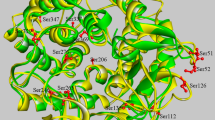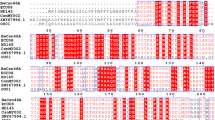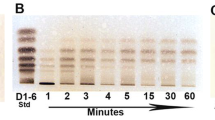Abstract
The chitosanase from Bacillus sp. TS (CsnTS) is an enzyme belonging to the glycoside hydrolase family 8. The sequence of CsnTS shares 98 % identity with the chitosanase from Bacillus sp. K17. Crystallography analysis and site-direct mutagenesis of the chitosanase from Bacillus sp. K17 identified the important residues involved in the catalytic interaction and substrate binding. However, despite progress in understanding the catalytic mechanism of the chitosanase from the family GH8, the functional roles of some residues that are highly conserved throughout this family have not been fully elucidated. This study focused on one of these residues, i.e., the aspartic acid residue at position 318. We found that apart from asparagine, mutation of Asp318 resulted in significant loss of enzyme activity. In-depth investigations showed that mutation of this residue not only impaired enzymatic activity but also affected substrate binding. Taken together, our results showed that Asp318 plays an important role in CsnTS activity.






Similar content being viewed by others
References
Adachi, W., Sakihama, Y., Shimizu, S., Sunami, T., Fukazawa, T., Suzuki, M., et al. (2004). Crystal structure of family GH-8 chitosanase with subclass II specificity from Bacillus sp K17. Journal of Molecular Biology, 343, 785–795.
Alzari, P. M., Souchon, H., & Dominguez, R. (1996). The crystal structure of endoglucanase CelA, a family 8 glycosyl hydrolase from Clostridium thermocellum. Structure, 4, 265–275.
Boucher, I., Dupuy, A., Vidal, P., Neugebauer, W. A., & Brzezinski, R. (1992). Purification and characterization of a chitosanase from Streptomyces N174. Applied Microbiology and Biotechnology, 38, 188–193.
Fukamizo, T., Honda, Y., Goto, S., Boucher, I., & Brzezinski, R. (1995). Reaction-mechanism of chitosanase from Streptomyces sp N174. The Biochemical Journal, 311, 377–383.
Gupta, V., Prasanna, R., Natarajan, C., Srivastava, A. K., & Sharma, J. (2010). Identification, characterization, and regulation of a novel antifungal chitosanase Gene (cho) in Anabaena spp. Applied and Environmental Microbiology, 76, 2769–2777.
Gupta, V., Prasanna, R., Srivastava, A. K., & Sharma, J. (2012). Purification and characterization of a novel antifungal endo-type chitosanase from Anabaena fertilissima. Annales de Microbiologie, 62, 1089–1098.
Honda, Y., Fukamizo, T., Boucher, I., & Brzezinski, R. (1997). Substrate binding to the inactive mutants of Streptomyces sp. N174 chitosanase: indirect evaluation from the thermal unfolding experiments. FEBS Letters, 411, 346–350.
Honda, Y., Kirihata, M., Fukamizo, T., Kaneko, S., Tokuyasu, K., & Brzezinski, R. (1999). Chitosanase-catalyzed hydrolysis of 4-methylumbelliferyl beta-chitotrioside. The Journal of Biochemistry-Tokyo, 126, 470–474.
Ike, M., Ko, Y., Yokoyama, K., Sumitani, J. I., Kawaguchi, T., Ogasawara, W., et al. (2007). Cellobiohydrolase I (Ce17a) from Trichoderma reesei has chitosanase activity. Journal of Molecular Catalysis B: Enzymatic, 47, 159–163.
Jung, W. J., & Park, R. D. (2014). Bioproduction of chitooligosaccharides: present and perspectives. Marine Drugs, 12, 5328–5356.
Karshikoff, A., Nilsson, L., & Ladenstein, R. (2015). Rigidity versus flexibility: the dilemma of understanding protein thermal stability. The FEBS Journal, 282, 3899–3917.
Kim, P. I., Kang, T. H., Chung, K. J., Kim, I. S., & Chung, K. C. (2004). Purification of a constitutive chitosanase produced by Bacillus sp. MET 1299 with cloning and expression of the gene. FEMS Microbiology Letters, 240, 31–39.
Lacombe-Harvey, M. E., Fortin, M., Ohnuma, T., Fukamizo, T., Letzel, T. and Brzezinski, R. (2013) A highly conserved arginine residue of the chitosanase from Streptomyces sp N174 is involved both in catalysis and substrate binding. BMC Biochemistry, 14.
Lacombe-Harvey, M. E., Fukamizo, T., Gagnon, J., Ghinet, M. G., Dennhart, N., Letzel, T., et al. (2009). Accessory active site residues of Streptomyces sp N174 chitosanase. The FEBS Journal, 276, 857–869.
Lebbink, J. H., Consalvi, V., Chiaraluce, R., Berndt, K. D., & Ladenstein, R. (2002). Structural and thermodynamic studies on a salt-bridge triad in the NADP-binding domain of glutamate dehydrogenase from Thermotoga maritima: cooperativity and electrostatic contribution to stability. Biochemistry, 41, 15524–15535.
Lee, H. S., Jang, J. S., Choi, S. K., Lee, D. W., Kim, E. J., Jung, H. C., et al. (2007). Identification and expression of GH-8 family chitosanases from several Bacillus thuringiensis subspecies. FEMS Microbiology Letters, 277, 133–141.
Liu, S., Shao, S., Li, L., Cheng, Z., Tian, L., Gao, P., et al. (2015). Substrate-binding specificity of chitinase and chitosanase as revealed by active-site architecture analysis. Carbohydrate Research, 418, 50–56.
Lyu, Q., Shi, Y., Wang, S., Yang, Y., Han, B., Liu, W., et al. (2015). Structural and biochemical insights into the degradation mechanism of chitosan by chitosanase OU01. Biochimica et Biophysica Acta, 1850, 1953–1961.
Lyu, Q., Wang, S., Xu, W., Han, B., Liu, W., Jones, D. N., et al. (2014). Structural insights into the substrate-binding mechanism for a novel chitosanase. The Biochemical Journal, 461, 335–345.
Marcotte, E. M., Monzingo, A. F., Ernst, S. R., Brzezinski, R., & Robertus, J. D. (1996). X-ray structure of an anti-fungal chitosanase from Streptomyces N174. Nature Structural Biology, 3, 155–162.
Park, J. K., Shimono, K., Ochiai, N., Shigeru, K., Kurita, M., Ohta, Y., et al. (1999). Purification, characterization, and gene analysis of a chitosanase (ChoA) from Matsuebacter chitosanotabidus 3001. Journal of Bacteriology, 181, 6642–6649.
Pokhrel, S., Joo, J. C., & Yoo, Y. J. (2013). Shifting the optimum pH of Bacillus circulans xylanase towards acidic side by introducing arginine. Biotechnology and Bioprocess Engineering, 18, 35–42.
Rye, C. S., & Withers, S. G. (2000). Glycosidase mechanisms. Current Opinion in Chemical Biology, 4, 573–580.
Shimosaka, M., Kumehara, M., Zhang, X. Y., Nogawa, M., & Okazaki, M. (1996). Cloning and characterization of a chitosanase gene from the plant pathogenic fungus Fusarium solani. Journal of Fermentation and Bioengineering, 82, 426–431.
Tanabe, T., Morinaga, K., Fukamizo, T., & Mitsutomi, M. (2003). Novel chitosanase from Streptomyces griseus HUT 6037 with transglycosylation activity. Bioscience, Biotechnology, and Biochemistry, 67, 354–364.
Tremblay, H., Yamaguchi, T., Fukamizo, T., & Brzezinski, R. (2001). Mechanism of chitosanase-oligosaccharide interaction: subsite structure of Streptomyces sp N174 chitosanase and the role of Asp57 carboxylate. The Journal of Biochemistry-Tokyo, 130, 679–686.
Viens, P., Lacombe-Harvey, M. E., & Brzezinski, R. (2015). Chitosanases from family 46 of glycoside hydrolases: from proteins to phenotypes. Marine Drugs, 13, 6566–6587.
Xia, W. S., Liu, P., Zhang, J. L., & Chen, J. (2011). Biological activities of chitosan and chitooligosaccharides. Food Hydrocolloids, 25, 170–179.
Zhou, Z. P., Zhao, S. Z., Wang, S. Q., Li, X. M., Su, L., Ma, Y. H., et al. (2015). Extracellular overexpression of chitosanase from Bacillus sp TS in Escherichia coli. Applied Biochemistry and Biotechnology, 175, 3271–3286.
Zitouni, M., Fortin, M., Scheerle, R. K., Letzel, T., Matteau, D., Rodrigue, S., et al. (2013). Biochemical and molecular characterization of a thermostable chitosanase produced by the strain Paenibacillus sp 1794 newly isolated from compost. Applied Microbiology and Biotechnology, 97, 5801–5813.
Acknowledgments
This work was supported, in part, by grants from the Hundred Talents Program of the Chinese Academy of Sciences (CAS), the Knowledge Innovation Program of CAS (KSCX2-EW-G-8), and the Tianjin Municipal Science and Technology Commission (10ZCKFSY05600). J.L. is an Australian National Health and Medical Council (NHMRC) Senior Research Fellow. J.S. is a recipient of the Hundred Talents Program of CAS.
Author information
Authors and Affiliations
Corresponding author
Ethics declarations
This article does not contain any studies with human participants or animals performed by any of the authors and the authors declare that they have no competing interest.
Electronic supplementary material
ESM 1
(DOCX 20 kb)
Rights and permissions
About this article
Cite this article
Zhou, Z., Zhao, S., Liu, Y. et al. A highly Conserved Aspartic Acid Residue of the Chitosanase from Bacillus Sp. TS Is Involved in the Substrate Binding. Appl Biochem Biotechnol 180, 1167–1179 (2016). https://doi.org/10.1007/s12010-016-2159-8
Received:
Accepted:
Published:
Issue Date:
DOI: https://doi.org/10.1007/s12010-016-2159-8




